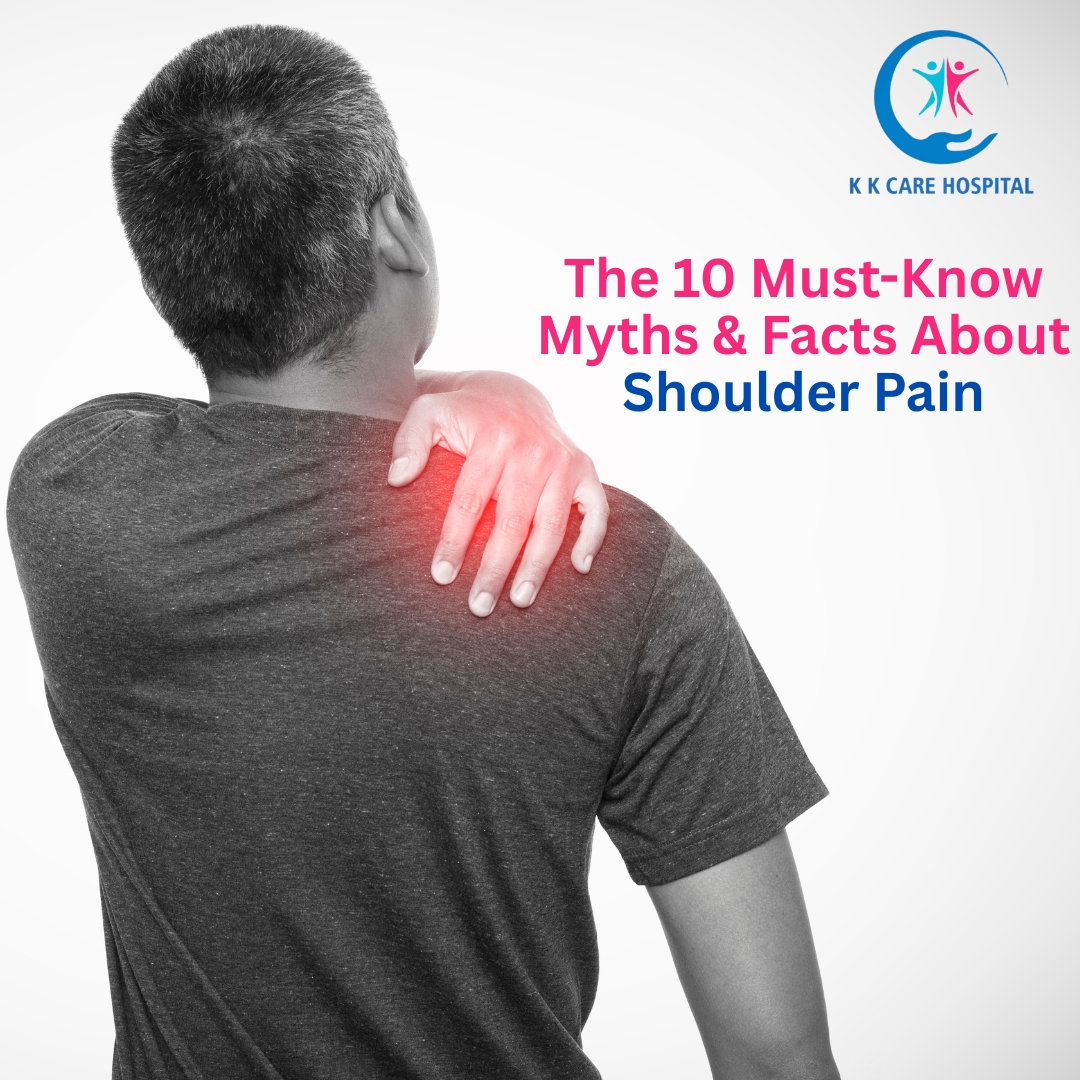Shoulder pain is more common than many people realise—and equally misunderstood. At KK Care Hospital, we see patients who delay seeking help or follow incorrect advice simply because of widely-held myths. Here, we uncover 10 of the biggest myths about shoulder pain and provide the clear facts you should know.
Myth 1: “My shoulder pain isn’t serious – it’ll just disappear on its own.”
Fact: While minor aches may resolve with rest, not all shoulder pain is harmless. Ignoring symptoms like persistent stiffness, weakness or “locking” of the arm can allow underlying problems—such as tendon injuries, bursitis or impingement—to worsen.
Take-away: If your shoulder pain lasts more than a week or two, or limits your movement, it’s wise to get it evaluated.
Myth 2: “Shoulder problems always stem from a single injury or trauma.”
Fact: Many shoulder pains develop gradually from overuse, poor posture or repetitive motions—not just from one big fall or accident. For example, working overhead, sleeping in awkward positions or even mild daily strain can contribute.
Take-away: Even without a dramatic incident, shoulder pain is valid and treatable.
Myth 3: “If I can still move my shoulder, then the injury can’t be serious.”
Fact: In many cases—particularly with conditions like a partial tear of the rotator cuff or chronic tendonitis—movement may still be possible despite serious damage.
Take-away: Don’t equate the ability to move freely with being problem-free. Pain, weakness or limited range when lifting overhead are red flags.
Myth 4: “Only very active or athletic people get shoulder pain.”
Fact: While athletes and people doing heavy overhead work are at higher risk, sedentary people can get shoulder pain too. Poor posture, long hours at a desk, weak shoulder muscles or shoulder-blade instability are common culprits.
Take-away: Whether you’re active or not, shoulder health matters.
Myth 5: “If it doesn’t hurt much at the moment, I can safely ignore it.”
Fact: Some shoulder problems begin with subtle signs like mild ache, clicking, stiffness or difficulty reaching behind your back. Pain might not be severe initially but can progress.
Take-away: Early recognition improves outcomes. Don’t wait until the pain is severe.
Myth 6: “Rest is the best treatment for shoulder pain—just don’t move it.”
Fact: While rest is useful immediately after an acute injury, complete immobilization often does more harm than good. Shoulder joints and soft tissues can stiffen, leading to worse outcomes. Movement and guided exercise are important in many cases.
Take-away: A balanced approach—rest where necessary, but follow active rehab as advised.
Myth 7: “Shoulder pain is just a part of ageing—there’s nothing much I can do.”
Fact: Although age-related degeneration (such as thinning of tendons) can play a role, many effective treatments exist. Shoulder issues are not inevitable and unchangeable.
Take-away: Don’t accept persistent shoulder pain as “just normal age wear and tear”. You have options.
Myth 8: “Heat is always better than ice (or vice-versa) for shoulder pain.”
Fact: The truth is: both heat and ice can be useful depending on the underlying problem and stage. For instance, ice may help acute inflammation while heat can ease stiffness or chronic ache.
Take-away: Use the right modality for your condition and stage—not a one-size-fits-all approach.
Myth 9: “Imaging (like MRI) is required for every shoulder pain case.”
Fact: While imaging can be helpful in certain cases, many shoulder problems are diagnosed with a careful physical examination, movement tests and patient history. Imaging may be reserved for cases that don’t improve or where surgery is considered.
Take-take: Don’t insist on an MRI immediately—seek professional evaluation first.
Myth 10: “Once I have shoulder pain, I’ll likely have it forever.”
Fact: Many patients experience full or near-full recovery with appropriate treatment. Leaving shoulder pain untreated, however, can lead to chronic issues, reduced movement, weakness and ongoing discomfort.
Take-away: With timely care, shoulder pain is conquerable.
Why These Myths Matter
When myths rule how we respond to shoulder pain, the consequences include delayed diagnosis, unnecessary inactivity, worsening stiffness and even the need for more invasive treatments. By understanding the facts, you empower yourself to seek the right care at the right time—and avoid unnecessary suffering.
What You Can Do – Practical Tips
- See a specialist early: If shoulder pain lasts more than a few weeks, or you have difficulty lifting your arm, reach out to an experienced shoulder specialist.
- Maintain good posture: Being mindful of how you sit, sleep and move can reduce strain on your shoulders.
- Follow a guided rehab plan: Under a physiotherapist or doctor’s guidance, progressive exercises (strength + mobility) matter more than simply avoiding use.
- Use your tools wisely: Ice, heat, analgesics, rest and movement all have their role—use them appropriately for your condition.
- Stay active (smartly): Avoid heavy overhead lifting or pushing through pain, but also avoid the trap of complete inactivity.
- Listen to your body: Popping, clicking, sudden weakness or night-pain are signs that you shouldn’t ignore.
When to Seek Medical Help Immediately
- Sudden inability to lift the arm or hold it up.
- Intense pain at night that keeps you from sleeping.
- Numbness or tingling in the arm or hand along with shoulder pain.
- Shoulder deformity after a fall or trauma.
- No improvement after 4–6 weeks of conservative treatment.






No comment